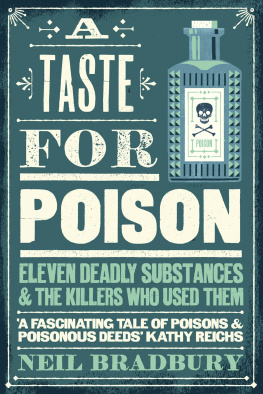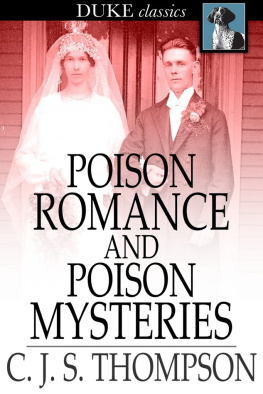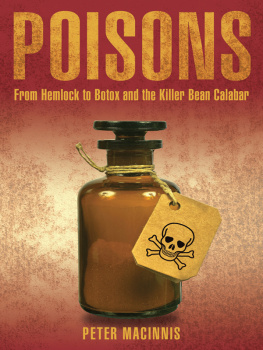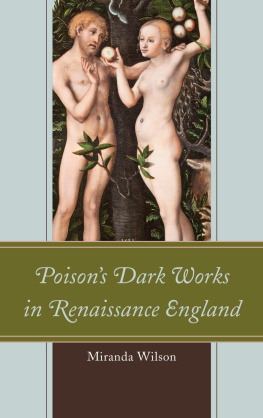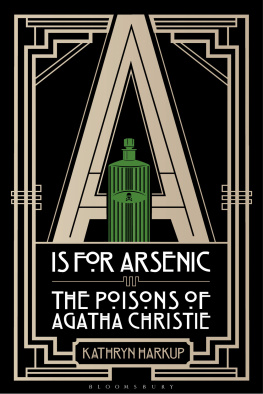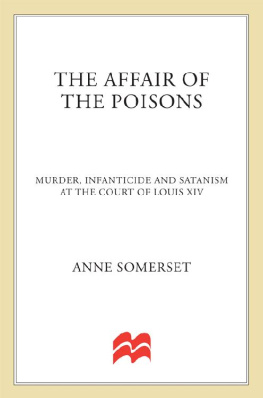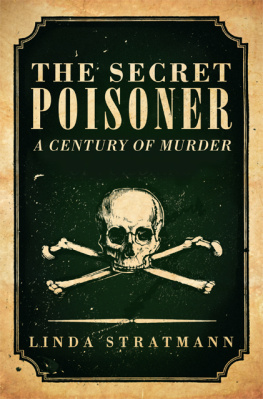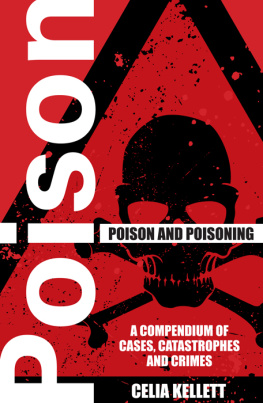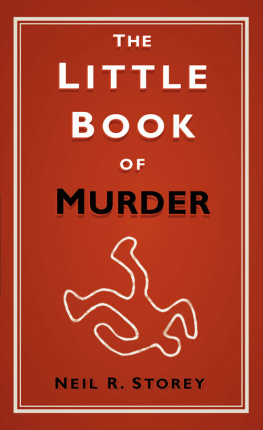Dr Neil Bradbury is Professor of Physiology and Biophysics at the Rosalind Franklin University of Medicine and Science, where he teaches and conducts research on genetic diseases. A full-time scientist and educator, Bradbury has won numerous awards for his unique approach to teaching physiology. He has presented his research around the world and authored more than 80 scientific articles and book chapters. Born in Manchester and educated in Britain, he currently lives in Illinois with his wife and two border collies. A Taste for Poison is his first book.
Australia
HarperCollins Publishers Australia Pty. Ltd.
Level 13, 201 Elizabeth Street
Sydney, NSW 2000, Australia
www.harpercollins.com.au
Canada
HarperCollins Canada
Bay Adelaide Centre, East Tower
22 Adelaide Street West, 41st Floor
Toronto, Ontario, M5H 4E3
www.harpercollins.ca
India
HarperCollins India
A75, Sector 57
Noida, Uttar Pradesh 201 301, India
www.harpercollins.co.in
New Zealand
HarperCollins Publishers New Zealand
Unit D1, 63 Apollo Drive
Rosedale 0632
Auckland, New Zealand
www.harpercollins.co.nz
United Kingdom
HarperCollins Publishers Ltd.
1 London Bridge Street
London SE1 9GF, UK
www.harpercollins.co.uk
United States
HarperCollins Publishers Inc.
195 Broadway
New York, NY 10007
www.harpercollins.com
A huge thank-you to my wife and daughters for their continued support and encouragement during the writing of this book. You are a constant source of joy and happiness. I hope my wife will finally be convinced that the many scribbled notes on poisons that she found lying around really were for a book! I am also indebted to my parents for their lifelong support, particularly during my undergraduate and graduate studies in biochemistry, even when they were not quite sure what biochemistry was.
The writing of this book would have remained a daydream were it not for the support of my agent, Jessica Papin, at the Dystel, Goderich & Bourret literary agency. I owe a lot to Jessica for her enthusiastic reception of the proposal right from the start, and without her this book would not be possible. (My zeal for gerund verbs has been significantly curtailed thanks to Jessicas input.) I would also like to thank my wonderful editors at St. Martins Press, Sarah Grill and Charles Spicer, who had a vision for what this book could be, and helped shape it into what it is. Despite Sarahs contention that she learned a lot from me in reading and rereading the manuscript, in fact I learned a lot more from her, greatly elevating my writing skills. She helped keep me on track, and away from the scientific meanderings to which I was prone.
I also wish to thank the friends and colleagues, including Drs. Robert Bridges, Hector Rasgado-Flores, Pat McCormack, and Bonnie Blazer-Yost, who took time to review the science in the book. I thank them for their diligence, though any errors or omissions in the science remain entirely mine. Thanks also to my biochemistry professors at the University of St. Andrews in Scotland for initiating my interest in poisons, though I am sure that was not the intent of the course. I am sure many of the experiments we performed as undergraduates, including those with cyanide, are probably not allowed any longer. Finally, I would like to thank all the students who have passed through my classes during my years of teaching. You have always given an enthusiastic reception to my use of murder as a means to understand physiology. I am grateful for the privilege of helping you in your own journey of discovery. If I have omitted anyone from my thanks, I apologize but remain gratefulif embarrassed.
Authors Note: The following information is purely for educational purposes only, and is not intended to give the advantages or disadvantages for the use of any particular poison in the commission of murder.
Note: 1 tsp is around 5,000 mg
ACONITE
Route of entry: Ingestion
Lethal Dose: Around 2 mg
Target: Alters signaling along the nervous system
Symptoms: Nausea, vomiting, diarrhea, burning, tingling, and numbness in the mouth and face, spreading to the limbs; sweating, dizziness, respiratory distress, delirium, paralysis of the lungs and heart
Antidote: None specific; may use cardiac drugs to counteract effects of aconite
ARSENIC
Route of entry: Ingestion
Lethal Dose: 40100 mg
Target: Potentially every sulfur-containing enzyme in every cell of the body; halts energy production and cellular repair
Symptoms: Violent vomiting and diarrhea, abdominal pain, muscle spasms, difficulty swallowing, intense thirst, soreness in mouth and throat with difficulty swallowing, weak pulse, kidney failure, coma; death within 1236 hours
Antidote: Dimercaprol, also known as British anti-Lewisite, binds tightly to arsenic and renders it inactive; can also be used to treat acute poisoning by mercury, gold, and lead
ATROPINE
Route of entry: Usually ingestion
Lethal Dose: In excess of 50 mg
Target: Neurotoxin, blocks normal synaptic transmission by blocking acetylcholine receptor
Symptoms: Extreme dryness of the mouth, slurred speech, hallucinations, blurred vision, sensitivity to light, delirium, urinary retention, rapid heart rate, respiratory paralysis
Antidote: None specific, though physostigmine may be used to counteract some effects.
CHLORINE
Route of entry: Injection and inhalation
Lethal Dose: 3451 parts per million in the air as chlorine gas; 20 g for an oral dose; 2 g for an IV dose.
Target: Blood cells, muscle, delicate tissues of airways, nose, eyes
Symptoms: Injection leads to breakdown of blood cells, causing anemia, reduced oxygen delivery to kidneys and brain; oxidation damage to blood proteins; inhalation leads to chemical burns of throat, airways, and lungs, leading to respiratory distress; fluid collects around the lungs, making breathing difficult
Antidote: None
CYANIDE
Route of entry: Inhalation and ingestion
Lethal Dose: Around 500 mg
Target: Targets the mitochondria, shutting off energy production
Symptoms: Convulsions, low blood pressure, low heart rate, coma, lung damage, respiratory failure, cardiac arrest
Antidote: Cobalt salts such as dicobalt-edetateor vitamin B12
Note: Cyanide is one of the fastest-acting poisons known to man
DIGOXIN
Route of entry: Ingestion or injection
Lethal Dose: Few mg
Target: Causes blockage of electrical signaling in the heart
Symptoms: Dizziness, confusion, hallucinations, abdominal pain, muscle pain, weakness, nausea, vision changes, irregular heartbeat, palpitations, breathing difficulties, cardiac arrest
Antidote: Atropine or Digibind (antibodies that mop up excess digoxin)
INSULIN
Route of entry: Injection only
Lethal Dose: 400600 units, equivalent to 1331 mg
Target: Liver, muscles, adipose insulin receptors, causing drastic drop in blood sugar
Symptoms: Sweating, vomiting, weakness, irritability, confusion, coma
Antidote: IV glucose
POLONIUM-210
Route of entry: Ingestion
Lethal Dose: Around 0.0005 mg
Target: DNA in the nucleus of each cell
Symptoms: Severe headache, diarrhea, vomiting, hair loss, widespread damage of all internal organs; death within days to weeks

